|
Hydroponic Systems - The Basics
What follows is a hydroponics primer covering the basics of the systems and methods commonly used. Our hope is to give you enough information to get you started with evaluating the different systems and with choosing the right one for you. Our FAQ page also offers some helpful information.
What kinds of hydroponic systems are there?
Hydroponic systems include: Nutrient Film Technique (NFT); Drip (or Top) Watering; Aeroponic; Cloning; and Ebb & Flow (flood & drain) methods. Basically, all systems feature a reservoir and some type of container for the plant(s) to grow in, such as pots, trays, etc. What differentiates them is how the nutrient solution is delivered to the roots. (See below for details of systems.)
The above systems can be divided into two basic types of hydroponic systems: media-based and water (or aqua) culture.
Media-based systems use some form of growing media, which provide support for the roots. There is a greater selection of media-based systems to choose from to accommodate different plants and plant sizes. Some popular media-based systems include ebb-and-flow (also called flood-and-drain), run-to-waste, drip-feed (or top-feed), and bottom-feed systems.
Water culture systems can be used either with or without grow media. These systems, however, require frequent attention since growth rates are high. Abundant and good-quality fresh water and electricity must be readily available. Also, rapidly growing plants need to be maintained. Vines require trellising (external support), and fruit and flowers must be harvested in a timely manner. Some popular water culture systems are raft (also called floating and raceway), nutrient film technique (NFT), and aeroponics.
Media-based and water culture systems can then be broken down into either “active” or “passive” categories.
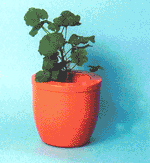
Active and Passive Systems
Active systems rely on a pump to flow nutrient around the plants’ roots and to provide aeration (as roots need lots of oxygen). Passive systems work without a pump (pictured to the right). Either a wicking material draws nutrients up to the roots, or the root tips are suspended in a stationary solution with the main portion of the rootball hanging in the air.
What are the specifics of the different systems or techniques?
Nutrient Film
 Features: Plants are placed in shallow troughs that have lids with holes in them (to allow for plant growth). An oxygen-rich nutrient solution is pumped into the troughs forming a thin film that runs along the bottom of these grow channels. This feeds the lower roots & allows the upper roots to breath. As with the ebb & flow system, the flow of water is controlled by a pump submersed in your nutrient solution. Features: Plants are placed in shallow troughs that have lids with holes in them (to allow for plant growth). An oxygen-rich nutrient solution is pumped into the troughs forming a thin film that runs along the bottom of these grow channels. This feeds the lower roots & allows the upper roots to breath. As with the ebb & flow system, the flow of water is controlled by a pump submersed in your nutrient solution.
Plants: Best suited for low-growing plants: lettuce, herbs, strawberries, flowers, etc. Larger plants grown to maturity require a support system.
Advantages: Like ebb & flow systems, NFT systems are easy to plant and harvest as all the work is done at waist level.
Drip Watering Systems
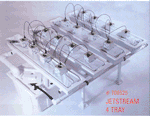 Features: Smaller reservoirs than ebb & flow systems. Features: Smaller reservoirs than ebb & flow systems.
Plants: Well suited for tomatoes, cucumbers, peppers, herbs & flowers.
Advantages: Economic use of nutrients & water & less salt build-up. You can use any grow media you prefer, such as, rockwool, coir fiber, or pots filled with grow rock or perlite. Top feed allows the grower greater flexibility with larger configurations. Available in modular & ready-to-grow configurations.
Aeroponics
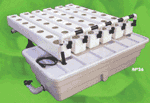 Features: A reservoir & grow trays with net pots & lids. The roots hang in an enclosed chamber. A sequence timer mists the root zone with a very high level of oxygen-rich nutrient solution, resulting in greater nutrient & water uptake. Features: A reservoir & grow trays with net pots & lids. The roots hang in an enclosed chamber. A sequence timer mists the root zone with a very high level of oxygen-rich nutrient solution, resulting in greater nutrient & water uptake.
Plants: Good for starting large crops of transplants & cuttings and growing crops to full maturity.
Advantages: Very aggressive growth rates. Available in modular & ready-to-grow configurations.
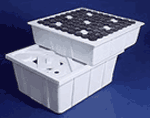 Cloning Machines Cloning Machines
Features: Uses the aeroponics misting & oxygen-rich process to propagate cuttings for transplant into soil or soilless growing systems.
Plants: Cuttings from any plant.
Advantages: Reduces the expense of purchasing starter plants.
Ebb & Flow [flood & drain]
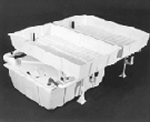 Features: Consists of a grow tray, stand, pump & fittings. The tray holds the plants, the growing medium & the nutrient solution. As with the NFT system, a pump is used to feed the plants with nutrient & to drain the tray. The timer is used to regulate the pump, feeding the system for 15 minutes every hour. As the name suggests, grow trays are flooded & drained & use rockwool or coco fiber slabs or grow pots w/soilless grow media to contain the plants. These systems use larger reservoirs to allow for plenty of water & to inhibit salt build-up. Features: Consists of a grow tray, stand, pump & fittings. The tray holds the plants, the growing medium & the nutrient solution. As with the NFT system, a pump is used to feed the plants with nutrient & to drain the tray. The timer is used to regulate the pump, feeding the system for 15 minutes every hour. As the name suggests, grow trays are flooded & drained & use rockwool or coco fiber slabs or grow pots w/soilless grow media to contain the plants. These systems use larger reservoirs to allow for plenty of water & to inhibit salt build-up.
Plants: Ideal for seedlings, cuttings, for vegetating young plants and for full-term crop production; they are very versatile.
Advantages: Allows higher density planting. They are versatile in application & easy to use & operate. Like NFT systems, these systems are easy to plant & harvest as all the work is done at waist level. Available in modular & ready-to-grow configurations.
|

